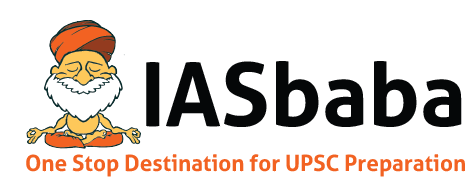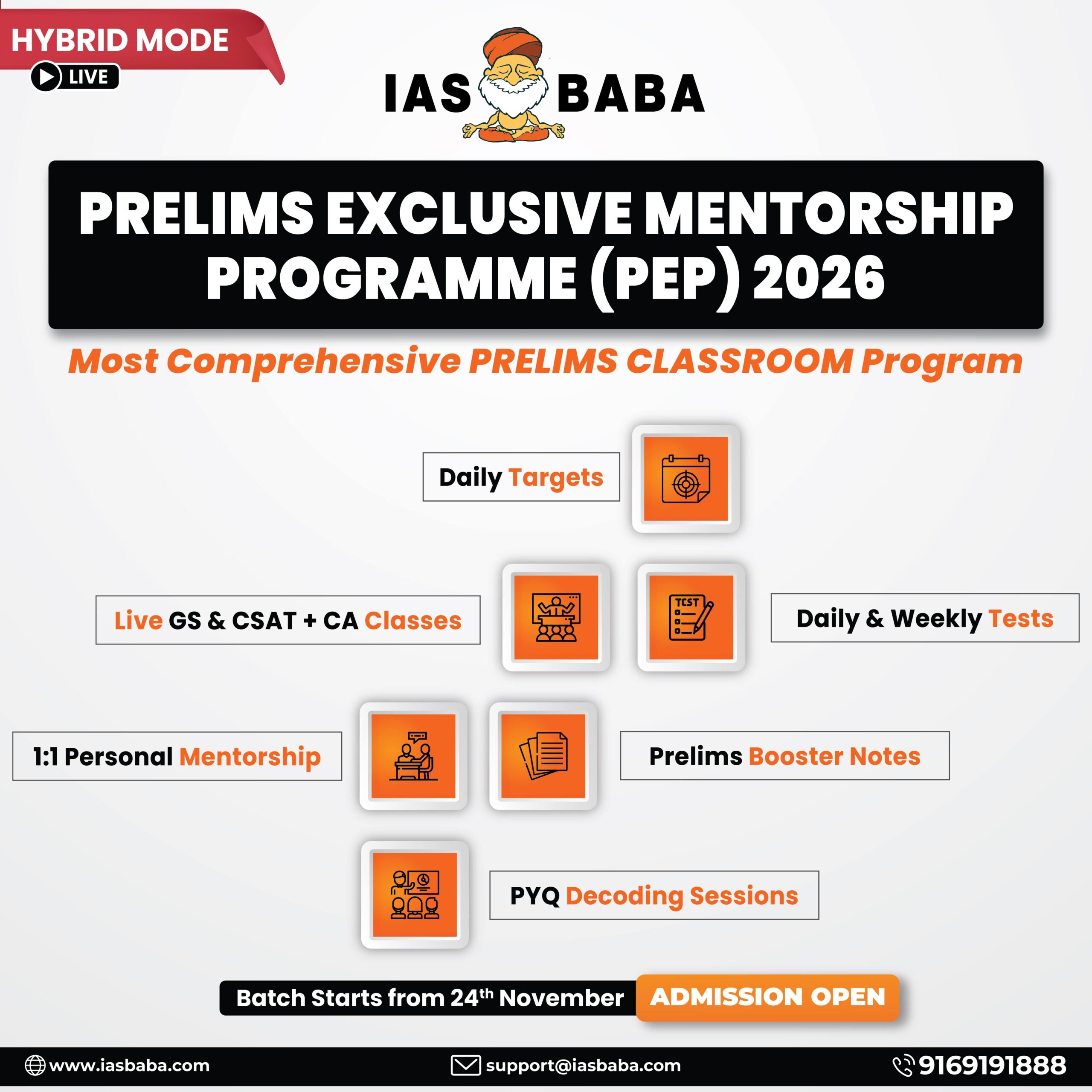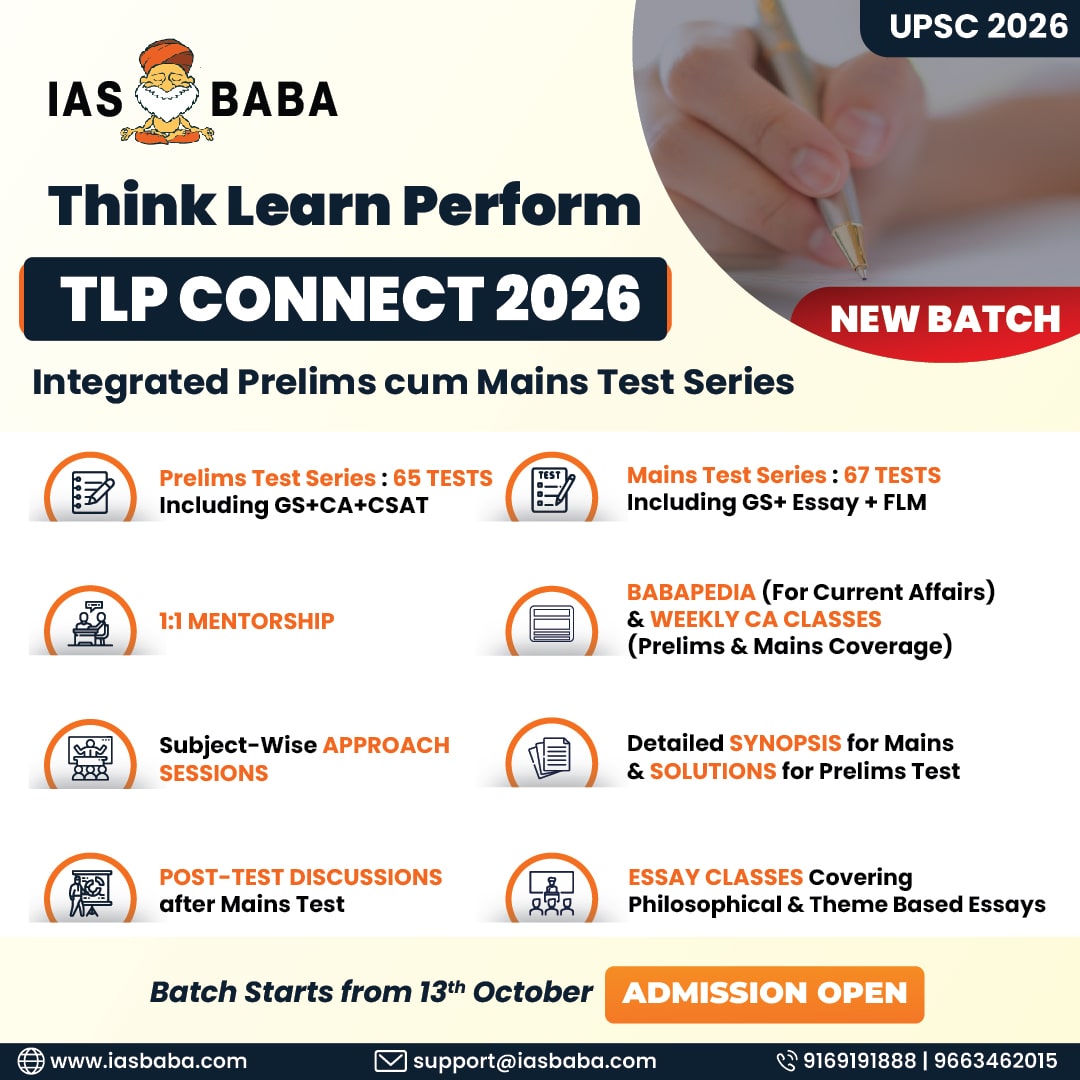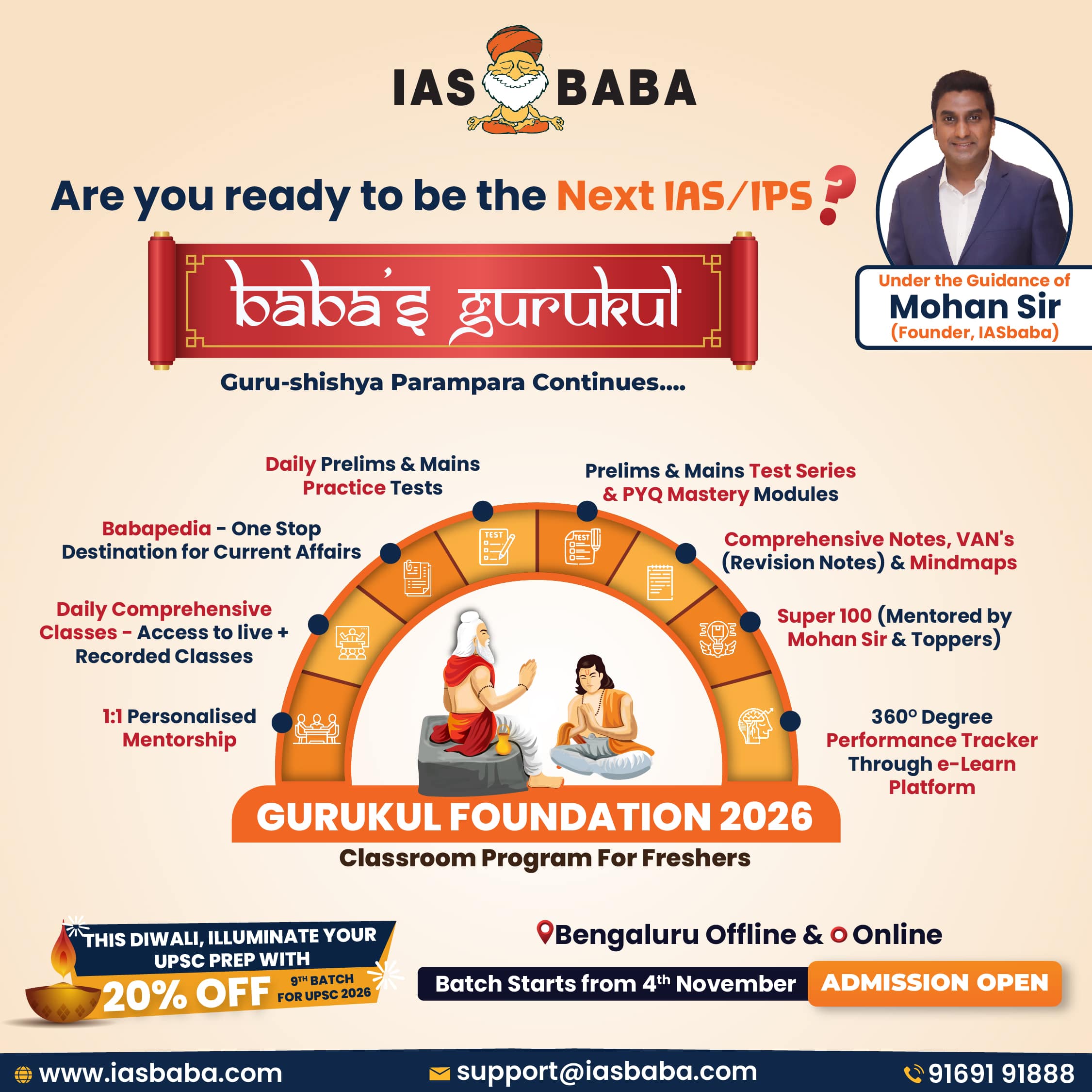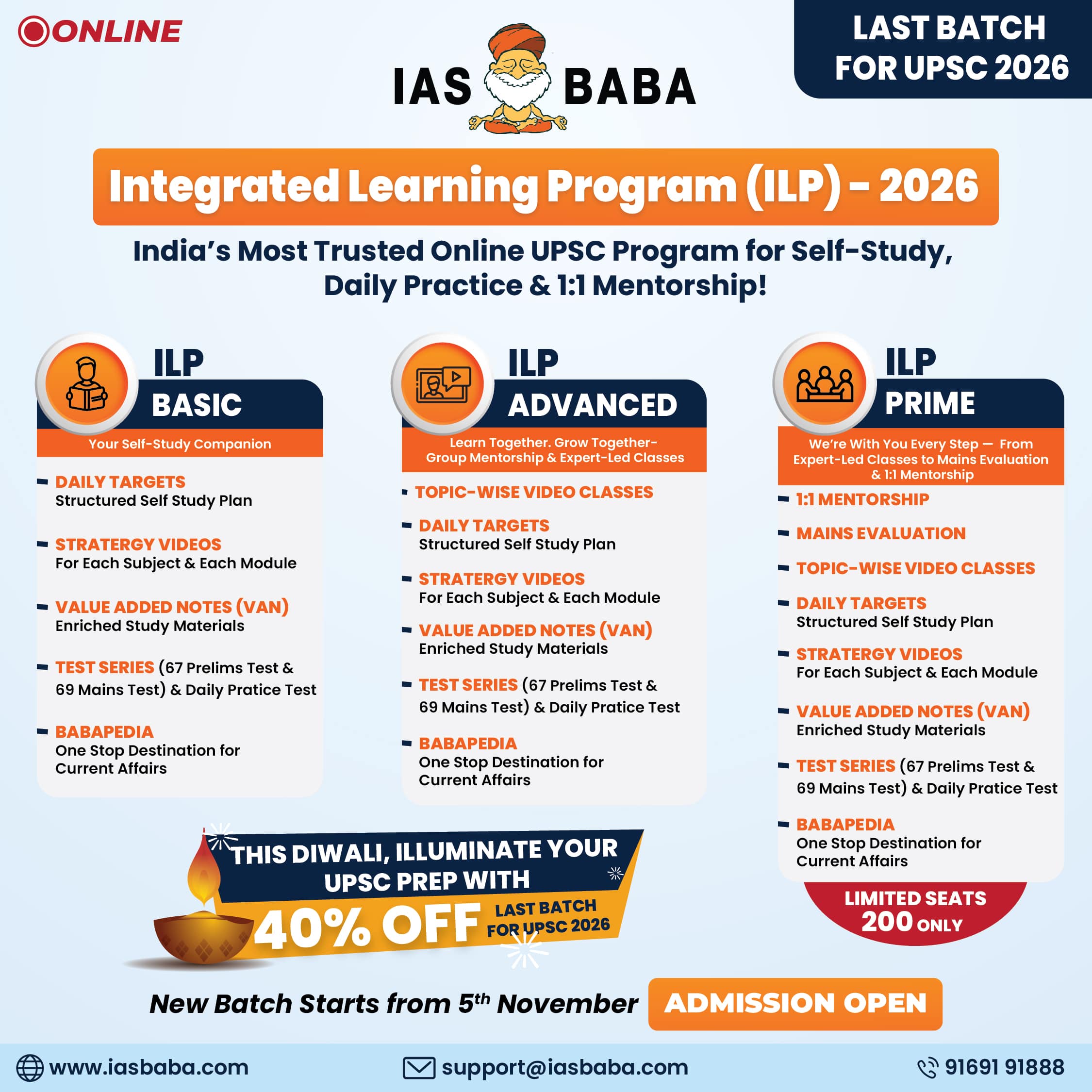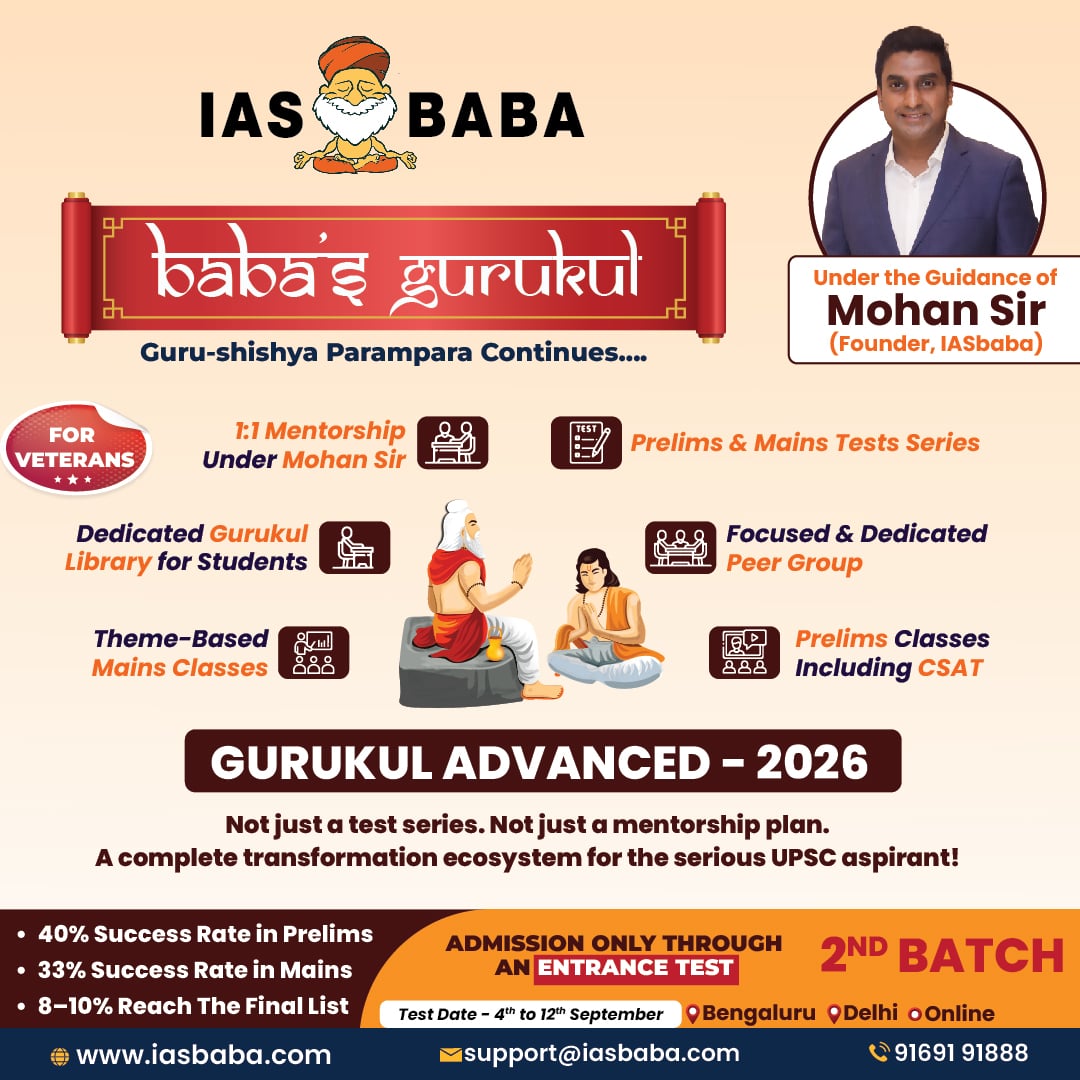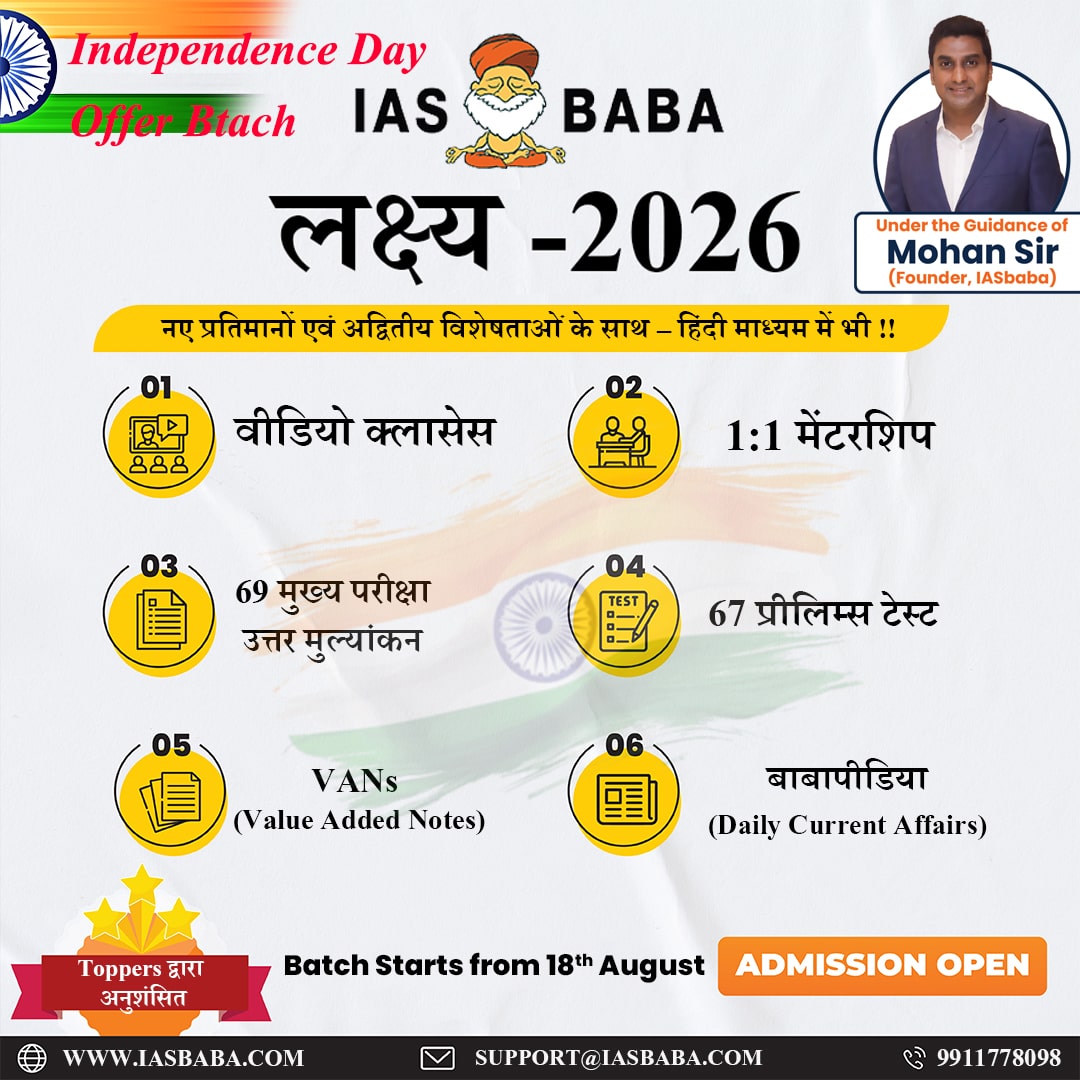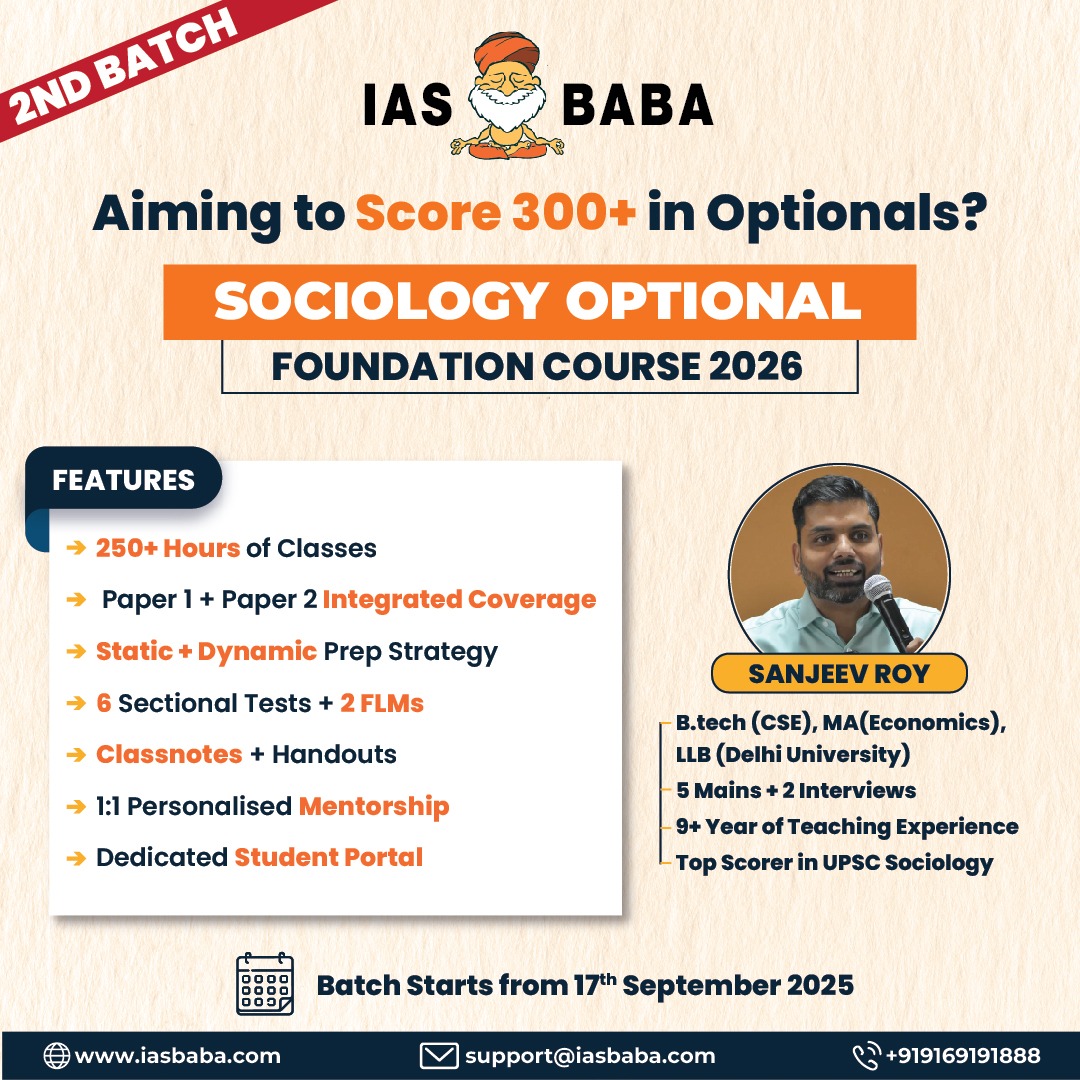IASbaba's Daily Current Affairs Analysis
Archives
(PRELIMS Focus)
Category: SCIENCE AND TECHNOLOGY
Context: Indian Astronaut in Space After 41 Years
Decoding Context:
Mission Highlights
- Launch: June 25, 2025, from NASA’s Kennedy Space Center on SpaceX’s Falcon 9 and Crew Dragon “Grace”.
- Crew: Peggy Whitson (USA), Sławosz Uznański (Poland), Tibor Kapu (Hungary), and Shukla (India).
- Duration: 14 days aboard the ISS.
- Objectives: Conducting over 60 scientific, educational, and commercial experiments, including seven from Indian researchers selected by ISRO.
- Historic First: Shukla is the first Indian to visit the ISS.
Historical Context
- Rakesh Sharma’s 1984 Mission: Conducted aboard a Soviet Soyuz to Salyut 7 for 7 days, focused on Earth observation.
- Shukla’s Mission: Broader scientific goals with international cooperation, longer duration, and commercial involvement.
Comparison: Rakesh Sharma vs. Shubhanshu Shukla
| Feature | Rakesh Sharma (1984) | Shubhanshu Shukla (2025) |
|---|---|---|
| Spacecraft | Soviet Soyuz | SpaceX Crew Dragon (Grace) |
| Launch Site | Kazakhstan | Florida, USA |
| Space Station | Salyut 7 (Soviet) | ISS (International) |
| Duration | ~7 days | ~14 days |
| Focus | Earth observation | Scientific & educational |
| National Context | Soviet collaboration | International, commercial |
Learning Corner:
International Space Station (ISS)
The International Space Station (ISS) is a large, habitable space laboratory orbiting Earth, where astronauts from around the world live and work. It represents one of the greatest examples of international scientific and technological collaboration.
Key Facts
- Launched: First module in 1998
- Orbit: About 400 km above Earth
- Speed: Travels at ~28,000 km/h; orbits Earth every ~90 minutes
- Size: Largest human-made body in space, size of a football field
Participating Space Agencies
- NASA (USA)
- Roscosmos (Russia)
- ESA (Europe)
- JAXA (Japan)
- CSA (Canada)
Other nations also participate through collaborations.
Objectives
- Microgravity Research: Study biology, physics, astronomy, and materials science in space conditions
- Technology Testing: For future missions (e.g., Moon, Mars)
- International Cooperation: Symbol of peaceful space exploration
- Commercial and Educational Activities: Includes experiments by private companies and student research
Source: THE HINDU
Category: POLITY
Context: The 56th GST Council meeting, expected in late June or early July 2025, will consider a proposal to eliminate the 12% GST slab, aiming to simplify India’s current four-rate system (5%, 12%, 18%, 28%) into a three-tier structure.
Key Proposals
- Remove 12% Slab: Items currently taxed at 12% may be shifted either to:
- 5% (essential/common-use items), or
- 18% (non-essential/higher-value items).
- Alternative Option: A new 15% slab by merging 12% and 18% is also under discussion, though less favored.
Rationale
- Simplification: Part of efforts to streamline the tax structure.
- Revenue Neutrality: Supported by consistently strong GST collections.
- Stakeholder Demand: Industry and states have long advocated for a less complex GST system.
Possible Impact
Items like butter, ghee, fruit juice, processed food, and mobile phones—currently under 12%—may see GST rates revised depending on their essentiality.
Learning Corner:
GST Council
The Goods and Services Tax (GST) Council is a constitutional body established under Article 279A of the Indian Constitution by the 101st Constitutional Amendment Act, 2016. It is responsible for making key decisions related to the implementation and administration of the GST regime in India.
Composition
- Chairperson: Union Finance Minister
- Members:
- Union Minister of State (Finance)
- State Finance Ministers (or Ministers nominated by states)
Functions
The GST Council makes recommendations on:
- Tax rates for goods and services.
- Exemptions from GST.
- Threshold limits for registration.
- Model GST laws, rules, and principles of levy.
- Special provisions for some states (e.g., NE & hill states).
- Dispute resolution between Centre and States.
Decision-Making
- Voting pattern:
- Centre: 1/3rd weightage
- States (collectively): 2/3rd weightage
- A decision requires at least a 3/4th majority of weighted votes.
Significance
- Ensures cooperative federalism in tax administration.
- Promotes uniformity in the indirect tax structure across India.
- Plays a vital role in revenue sharing and resolving disputes among stakeholders.
Source: THE HINDU
Category: INTERNATIONAL
Context : At the NATO summit in The Hague on June 25, 2025, member states agreed to raise defence and security spending to 5% of GDP by 2035, marking the alliance’s largest military commitment since the Cold War.
Key Highlights
- New Spending Target:
- Total: 5% of GDP
- Core Defence (troops, weapons, etc.): 3.5%
- Broader Security (infrastructure, innovation, civil preparedness): 1.5%
- Annual Progress Review: Countries must submit yearly plans; a formal review will take place in 2029.
- Collective Defence Reaffirmed: Emphasizes NATO’s solidarity amid rising threats from Russia, terrorism, and cyber warfare.
- U.S. Influence: The decision follows long-standing U.S. pressure for greater burden-sharing among European allies.
- Divergence in Support: While most members back the plan, some like Spain, Belgium, and Slovakia have expressed difficulty in meeting the 5% target due to budgetary constraints.
Strategic Context
This move supports NATO’s largest rearmament drive in decades and reflects the need for stronger deterrence, enhanced readiness, and adaptability to modern threats, including the war in Ukraine and cyberattacks.
Learning Corner:
NATO (North Atlantic Treaty Organization)
The North Atlantic Treaty Organization (NATO) is a political and military alliance formed in 1949 to ensure collective defence and security for its member nations.
Founding and Purpose
- Established: April 4, 1949, by the North Atlantic Treaty (Washington Treaty)
- Headquarters: Brussels, Belgium
- Motto: “Animus in consulendo liber” (A mind unfettered in deliberation)
- Primary Objective: Safeguard the freedom and security of member countries through political and military means
Key Features
- Collective Defence: Under Article 5, an attack on one member is considered an attack on all.
- Invoked only once: After the 9/11 attacks in 2001.
- Members: 32 countries (as of 2025), including the U.S., Canada, most European nations, and new entrants like Finland and Sweden.
- Decision-Making: Based on consensus among all member states.
Functions
- Military Cooperation: Joint defense, training, and strategic planning
- Crisis Management: Peacekeeping and conflict resolution missions
- Cyber & Hybrid Threats: Addressing modern security challenges beyond traditional warfare
- Partnership Programs: Works with non-member countries to promote global stability
Source : THE HINDU
Category: SCIENCE AND TECHNOLOGY
Context: In agriculture, it is revolutionizing how crops respond to biotic (diseases) and abiotic (heat, drought) stresses
How It Works
- Uses Cas9 enzyme guided by custom RNA to target specific genes.
- Enables knockout of genes that cause disease susceptibility or enhancement of genes that promote resistance.
- Offers faster, more accurate improvements than traditional breeding.
Applications in Crops
- Disease Resistance: Disabling genes like BoBPM6 and BoDMR6 in cabbage boosts resistance to multiple diseases like Fusarium wilt and black rot.
- Heat & Drought Tolerance: Editing genes such as SiEPF2 in foxtail millet helps regulate water use and stomatal density, improving stress tolerance.
- Stronger Immunity: Enhances plant immune responses to evolving pathogens.
Benefits
- Reduces pesticide use, supporting eco-friendly farming.
- Accelerates breeding cycles, allowing rapid response to threats.
- Stabilizes yields under climate-induced stress conditions.
Learning Corner:
CRISPR Technology
CRISPR (Clustered Regularly Interspaced Short Palindromic Repeats) is a revolutionary gene-editing technology that allows scientists to modify DNA with high precision, efficiency, and speed.
Origin
- Discovered as a natural defence mechanism in bacteria, where it helps fight viruses.
- Adapted for gene editing using the CRISPR-Cas9 system, developed in the early 2010s.
How It Works
- The Cas9 enzyme acts like molecular scissors that cut DNA at targeted locations.
- A guide RNA (gRNA) directs Cas9 to a specific DNA sequence.
- Scientists can then delete, insert, or modify genes at that site.
Applications
- Medicine: Correcting genetic disorders like sickle cell anaemia, cancer therapies, and HIV treatment.
- Agriculture: Developing disease-resistant, heat- and drought-tolerant crops.
- Research: Studying gene functions in various organisms.
- Veterinary Science: Improving animal health and productivity.
Advantages
- High precision with minimal off-target effects
- Faster and cheaper than older gene-editing tools (e.g., TALENs, ZFNs)
- Applicable to a wide range of organisms
Concerns
- Ethical issues around editing human embryos
- Potential for unintended genetic consequences
- Calls for global regulation and oversight
Source: PIB
Category: ECONOMICS
Context: The Digital Payment Intelligence Platform (DPIP) is a new RBI-led initiative aimed at curbing digital payment frauds in India.
It is being developed as a Digital Public Infrastructure (DPI) to enable real-time data sharing and fraud detection across banks.
Why It’s Needed
- Surging Frauds: Bank frauds have tripled in FY25, reaching ₹36,014 crore.
- Sector-Specific Threats: Public banks face more loan frauds, while private banks report higher internet and card frauds.
Development & Structure
- Built by: Reserve Bank Innovation Hub (RBIH)
- In Partnership With: 5–10 major public and private banks
- Oversight: High-level committee chaired by A.P. Hota (former NPCI chief)
- Launch Timeline: Expected to be operational within a few months
Key Features
- Real-Time Intelligence Sharing: Banks will instantly share and act on fraud data
- AI-Powered Risk Analysis: Detects patterns to identify scams before they escalate
- Unified Banking Response: Recognizes digital fraud as a shared industry threat
Expected Impact
- Strengthens digital transaction security
- Reduces dependency on delayed manual fraud reporting
- Promotes trust and resilience in India’s digital payments ecosystem
Learning Corner:
Reserve Bank of India (RBI)
The Reserve Bank of India (RBI) is the central bank of the country and the apex institution responsible for regulating the monetary and financial system of India.
Establishment
- Founded: 1st April 1935 under the RBI Act, 1934
- Nationalised: 1st January 1949
- Headquarters: Mumbai
Core Functions
- Monetary Authority
- Controls inflation and liquidity through tools like repo rate, reverse repo rate, CRR, SLR, etc.
- Issuer of Currency
- Sole authority for issuing currency notes (except ₹1 note, issued by the Government of India).
- Custodian of Foreign Exchange
- Manages the Foreign Exchange Management Act (FEMA) and maintains forex reserves.
- Regulator of Financial System
- Supervises banks, NBFCs, and payment systems. Issues banking licenses and ensures stability.
- Government’s Banker
- Manages government accounts, borrowings, and public debt.
- Developmental Role
- Promotes financial inclusion, digital payments (like UPI), and priority sector lending.
Key Departments and Subsidiaries
- Monetary Policy Department (MPD)
- Department of Regulation (DoR)
- Subsidiaries: NABARD, NHB (transferred to GoI in 2019), RBIH (RBI Innovation Hub), etc.
Recent Initiatives
- Launch of Digital Rupee (CBDC)
- Promotion of Digital Public Infrastructure (DPI) like DPIP
- Strengthening cybersecurity and fraud detection in digital banking
- Emphasis on financial literacy and inclusion
Digital Public Infrastructure (DPI)
Digital Public Infrastructure (DPI) refers to foundational digital systems that enable essential public and private services at a population scale. DPI acts like the digital equivalent of physical infrastructure (such as roads or electricity), but for digital services like identity, payments, and data sharing.
Core Pillars of DPI
- Digital Identity
- Example: Aadhaar – provides unique identification to over a billion Indians.
- Digital Payments
- Example: Unified Payments Interface (UPI) – enables real-time, interbank, low-cost digital transactions.
- Data Exchange
- Example: Account Aggregator Framework, DigiLocker – secure sharing of personal data with user consent.
Key Features
- Open, interoperable, and inclusive digital architecture
- Scalable for public, private, and governance use
- Consent-based, ensuring user control over data
- Low-cost and high-efficiency, especially in delivering government welfare schemes
India’s Global Leadership in DPI
- India’s DPI model, called “India Stack,” is internationally acclaimed.
- Combines Aadhaar + UPI + DigiLocker + Jan Dhan + Mobile – ensuring financial and digital inclusion.
- India’s DPI helped deliver welfare schemes (e.g., DBT) during the COVID-19 pandemic.
Examples of DPI Initiatives
- CoWIN platform – COVID vaccination tracking
- ONDC (Open Network for Digital Commerce) – democratizing e-commerce
- DPIP (Digital Payment Intelligence Platform) – real-time fraud detection in banking
- National Digital Health Mission (NDHM) – digital health records
Source: THE ECONOMICS TIMES
(MAINS Focus)
Introduction (Context)
Migration is a demographic process involving the movement of people from one place to another, either temporarily or permanently. In India, internal migration constitutes a significant proportion of the population, with about 28.9% migration rate (2021). A significant portion of migration in India is for marriage, especially among women. Around 10%, however, migrate for work. This number is significantly higher in certain northern and eastern States such as Bihar. With an ever-increasing number of migrants travelling from poorer to richer areas in search of employment, the number of those effectively disenfranchised will only increase, unless mechanisms are put in place to facilitate voting by migrants. This undermines universal adult franchise, a foundational principle of Indian democracy. In the 2024 Lok Sabha elections, Bihar recorded only 56% turnout, far below the national average of 66%. This is significantly attributed to out-migration.
Types of Migration
- Intra-State Migration: Movement within the same state (≈85% of total migration).
- Inter-State Migration: Movement between states.
- Rural-Urban Migration: Dominated by seasonal or semi-permanent job seekers.
- Marriage-Related Migration: Predominantly involving women.
- Distress Migration: Forced movement due to poverty, conflict, or environmental reasons.
Issues Faced by Migrants in Voting
- Most migrants move temporarily or seasonally to other regions (often cities or different states) for work or family reasons. During elections, many are unable to return to their original place of residence, where they are registered as voters. As a result, they are effectively disconnected from the voting process in their home constituencies.
- Migrants, especially those working in the informal sector, often live in temporary housing or slums without proper documentation. Without proof of residence (like rent agreements or utility bills), they find it difficult to update their address on the electoral roll, which is a prerequisite for transferring voting rights to their new location.
- Because migrants are often not permanently settled, they are frequently left out of electoral rolls at both ends:
-
- Source (native place): They may have moved long ago or may be away during the time of voting.
- Destination (current location): They are usually not enrolled due to temporary status or lack of documentation.
This double exclusion leads to their political invisibility.
- Many migrants are not aware of the procedures to shift or update their voter registration. Even if they are, the process involves filling out forms, visiting government offices, and providing proofs — all of which can be time-consuming and complicated, especially for daily wage workers or those with limited literacy.
- There are no targeted campaigns or support systems by the Election Commission of India (ECI) focused on migrants. Unlike efforts made for other voter groups (e.g., women, senior citizens), migrants do not receive focused awareness drives, mobile registration camps, or facilitation services.
- Many migrant workers do not get paid leave on polling days. Since voting usually happens in their native place, travelling long distances without financial support or leave options becomes impractical. As a result, many skip voting, especially those in daily-wage or informal jobs.
Why voting rights are important?
- Migrants are citizens and deserve equal participation in the democratic process. Enabling them to vote ensures their representation in policymaking and upholds the principle of universal adult franchise.
- When migrants can vote, they gain the power to hold governments accountable for their rights and welfare — such as fair wages, housing, healthcare, and social security.
- High out-migration states like Bihar and Uttar Pradesh often see low voter turnout. Enabling migrants to vote helps correct this imbalance and ensures fair political weight to these regions.
- Many women migrate after marriage and remain unregistered voters. Facilitating their enrolment in new locations increases their political participation and voice in decision-making.
Mechanisms to Enable Migrant Voting
- Improved Access for Intra-State Migrants
- To improve voting access for intra-State migrants, especially those in the informal sector, the government must strictly enforce statutory polling-day holidays. This would ensure that workers are not forced to choose between their wages and their right to vote.
- Additionally, subsidized or free transport services on and before polling day would make it easier for migrants to return to their home constituencies to vote.
- State-wide awareness campaigns and the setting up of facilitation centres could help inform and guide migrant workers about voting procedures, dates, and their rights.
- Remote Electronic Voting Machines (RVMs)
- The Election Commission of India (ECI) piloted Remote Electronic Voting Machines (RVMs) in 2023 to address the needs of inter-State migrants. These machines were specially designed to handle voting for up to 72 constituencies from a single location.
- However, the RVM proposal faces several challenges.
- Political parties have raised concerns about transparency and the credibility of the machines.
- Logistically, managing deployment, ensuring secure pre-registration, and verifying migrant identities pose significant hurdles.
- There is also the difficulty of preventing duplication and ensuring the integrity of the process when migrants are spread across states..
- Postal Ballots for Migrants
- This system is already being implemented by the ECI for members of the armed forces. An extension of this model could help many migrants.
- The ECI would require migrants to register with the body well in advance, so the postal ballots can be issued.
- Operationally, this appears to be the easier form of remote voting to implement.
- However, the ECI would have to organise registration, issue ballot papers, and despatch these ballots to counting centres after voting all major administrative efforts.
- Changing Constituency Based on Residence
- For long-term migrants who have lived in one place for six months or more, the option of changing their voting constituency to the new place of residence could be offered. This would require valid documentation proving local residence.
- The key advantage of this method is that it allows representation based on current residence and concerns, encouraging civic integration of migrants into their host communities.
- However, this option may face political resistance from local residents and parties, who may fear demographic shifts. There is also a risk that migration could become politicised if seen as a tool to influence local electoral outcomes.
- Gender-Focused Electoral Drive
- A significant portion of female migrants move due to marriage, and many remain unregistered in their new constituencies. This leads to their exclusion from the electoral process.
- Special enrolment drives targeted at urban and peri-urban areas where many of these women settle can help address this gap. Such drives should include door-to-door campaigns, local awareness programs, and coordination with local authorities to ease documentation and registration processes for women voters..
6. Adopting a Mixed Approach
- No single mechanism fits all migrants due to their heterogeneous nature.
- A composite strategy using RVMs, postal ballots, improved access, and constituency change can enable large-scale inclusion.
- ECI must work with State governments, employers, and civil society to ensure proper implementation.
- Leveraging technology, creating portable voter ID systems, and pre-poll registration portals can simplify processes.
Conclusion
Migrants are economic contributors, but remain politically invisible. Enabling their participation in elections is not just a logistical challenge, but a democratic imperative. Bridging this gap through well-designed, inclusive electoral reforms will strengthen Indian democracy and uphold the spirit of universal adult suffrage enshrined in the Constitution.
Mains Practice Question
Q “Political inclusion of migrants is a necessary step towards economic justice.” Analyse. (250 words, 15 marks)
Introduction (Context)
- India faces a growing water crisis affecting economic growth, agriculture, cities, and public health.
- The country holds 18% of the world’s population but has only 4% of global freshwater resources.
- Water stress is aggravated by population growth, mismanagement, pollution, and climate change.
- The crisis is already evident through falling water tables, erratic rainfall, and urban shortages.
Current Status and Alarming Indicators
- According to NITI Aayog (2018), nearly 600 million Indians face high to extreme water stress.
- By 2030, India’s water demand may double, creating a 40% supply gap.
- India ranks 13th among the world’s 17 most water-stressed countries (World Resources Institute).
- Over 60% of irrigation and 85% of drinking water depends on groundwater, which is fast depleting.
- The 2024 Groundwater Quality Report found 70% of India’s water sources are contaminated.
Climate Change and Its Impact on Water Resources
- Climate change has increased the unpredictability of monsoons vital for 55% of India’s agriculture.
- A 2024 CEEW study found 55% of tehsils saw a 10% increase in extreme rainfall, triggering floods.
- Simultaneously, 33% of India’s land is drought-prone, with declining soil moisture in 48% of the area (Conscious Planet, 2024).
- Himalayan glaciers are melting faster, affecting rivers like the Ganga and Indus that support millions.
- The World Bank projects that climate-related water scarcity could cut India’s GDP by up to 12% by 2050.
Agricultural Vulnerability and Water Mismanagement
- Agriculture uses 80% of India’s freshwater, making it most exposed to water shortages.
- The Economic Survey (2018–19) reported that a 100mm drop in rainfall reduces farmer income by 15% (kharif) and 7% (rabi).
- Climate change could reduce agricultural incomes by 15–18%, and by up to 25% in unirrigated regions.
- Water-intensive crops like rice and sugarcane continue to dominate due to price and policy incentives.
- Micro-irrigation, which can reduce water use by 50%, covers only 9% of cultivated land.
- The Atal Bhujal Yojana promotes groundwater management but covers only 8,000 gram panchayats in 7 states — inadequate for the scale of the crisis.
Urban Water Distress
- Cities like Bengaluru, Chennai, and Delhi are facing seasonal water shortages and infrastructure failures.
- In 2019, Chennai’s reservoirs dried up completely, leaving millions without water access.
- NITI Aayog predicts that 21 cities, impacting over 100 million people, could deplete groundwater by 2030.
- Urban over-extraction, lack of rainwater harvesting, and poor planning exacerbate the problem.
Public Health and Water Quality Concerns
- Contaminated water causes around 2,00,000 deaths annually from waterborne diseases (NITI Aayog, 2018).
- Fluoride and arsenic affect 230 million people across 19 Indian states.
- Untreated sewage continues to pollute rivers like the Yamuna, making them unsafe for use.
- The World Bank’s “One Health” model — integrating environmental, animal, and human health — could save billions, but implementation is sluggish.
Existing Policy Framework and Gaps
- The National Water Mission aims to increase water-use efficiency by 20% by 2025, but lacks tracking systems.
- CEEW has proposed water accounting to monitor savings and direct water to critical sectors.
- India’s adaptation funding is only ₹260 per capita (2019–20), compared to ₹2,200 for mitigation.
- Financial tools like climate bonds and the 2023 Green Credit Programme can help mobilize funds.
- International partnerships, such as the World Bank’s $1 billion dam rehabilitation and ADB’s $50 million loan for Meghalaya’s water harvesting, show promise.
- However, the global water financing gap is $6.7 trillion by 2030 — demanding private sector involvement similar to models in Chile and Peru.
Way forward
- Jal Shakti Abhiyan has helped revive 1.5 lakh water bodies since 2019, but community engagement remains low. Women, who often fetch water, should be central to water governance and planning.
- Integrated Water Resources Management (IWRM) that is blending traditional methods, nature-based solutions, and technology is key to sustainable management.
- Policies must align across sectors water, energy, agriculture, and climate to prevent fragmented efforts. For instance, solar-powered irrigation could address groundwater depletion and reduce carbon emissions simultaneously.
Conclusion
India’s water crisis is not a challenge of capacity but of intent. The tools for building a water-secure and climate-resilient economy already exist. What is required is bold leadership, integrated policymaking, and grassroots-level engagement. Addressing water insecurity is not just an environmental necessity but a national imperative — one that underpins our agricultural sustainability, urban future, public health, and economic growth. With 1.4 billion lives at stake, delay is no longer an option.
Mains Practice Question
Q India’s water crisis is as much a governance challenge as it is an environmental one. Examine. (250 words, 15 marks)
Daily Practice MCQs
Today’s – Daily Practice MCQs’ will be updated in our “Daily Current Affairs Quiz” section on our website
Please click on the below link
